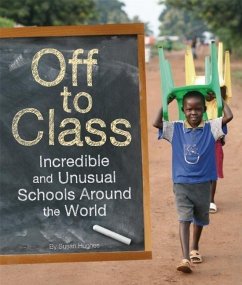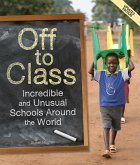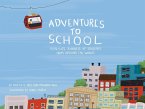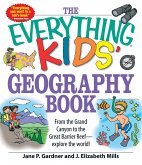13,99 €
inkl. MwSt.
Versandfertig in über 4 Wochen

7 °P sammeln
- Broschiertes Buch
- Merkliste
- Auf die Merkliste
- Bewerten Bewerten
- Teilen
- Produkt teilen
- Produkterinnerung
- Produkterinnerung
When North American kids picture a school, odds are they see rows of desks, stacks of textbooks, and linoleum hallways. They probably don't picture caves, boats, or train platforms -- but there are schools in caves, and on boats and on train platforms. There's a whole world of unusual schools out there! But the most amazing thing about these schools isn't their location or what they look like. It's that they provide a place for students who face some of the toughest environmental and cultural challenges, and live some of the most unique lifestyles, to learn. Education is not readily available…mehr
Andere Kunden interessierten sich auch für
![Off to Class (Updated Edition) Off to Class (Updated Edition)]() Susan HughesOff to Class (Updated Edition)15,99 €
Susan HughesOff to Class (Updated Edition)15,99 €![DK Super Readers Level 3 Homes Around the World DK Super Readers Level 3 Homes Around the World]() DkDK Super Readers Level 3 Homes Around the World6,99 €
DkDK Super Readers Level 3 Homes Around the World6,99 €![Adventures to School Adventures to School]() Miranda PaulAdventures to School17,99 €
Miranda PaulAdventures to School17,99 €![DK Super Readers Level 3 Homes Around the World DK Super Readers Level 3 Homes Around the World]() DkDK Super Readers Level 3 Homes Around the World14,99 €
DkDK Super Readers Level 3 Homes Around the World14,99 €![At School At School]() E C AndrewsAt School11,99 €
E C AndrewsAt School11,99 €![World Myths and Legends World Myths and Legends]() Kathy CeceriWorld Myths and Legends17,50 €
Kathy CeceriWorld Myths and Legends17,50 €![The Everything Kids' Geography Book The Everything Kids' Geography Book]() Jane P GardnerThe Everything Kids' Geography Book10,99 €
Jane P GardnerThe Everything Kids' Geography Book10,99 €-
-
-
When North American kids picture a school, odds are they see rows of desks, stacks of textbooks, and linoleum hallways. They probably don't picture caves, boats, or train platforms -- but there are schools in caves, and on boats and on train platforms. There's a whole world of unusual schools out there! But the most amazing thing about these schools isn't their location or what they look like. It's that they provide a place for students who face some of the toughest environmental and cultural challenges, and live some of the most unique lifestyles, to learn. Education is not readily available for kids everywhere, and many communities are strapped for the resources that would make it easier for kids to go to school. In short, it's not always easy getting kids off to class -- but people around the world are finding creative ways to do it. In "Off to Class," readers will travel to dozens of countries to visit some of these incredible schools, and, through personal interviews, meet the students who attend them, too. And their stories aren't just inspiring -- they'll also get kids to think about school and the world in a whole new way.
Hinweis: Dieser Artikel kann nur an eine deutsche Lieferadresse ausgeliefert werden.
Hinweis: Dieser Artikel kann nur an eine deutsche Lieferadresse ausgeliefert werden.
Produktdetails
- Produktdetails
- Verlag: Owlkids
- Seitenzahl: 64
- Altersempfehlung: 9 bis 12 Jahre
- Erscheinungstermin: 30. August 2011
- Englisch
- Abmessung: 256mm x 217mm x 7mm
- Gewicht: 240g
- ISBN-13: 9781926818863
- ISBN-10: 1926818865
- Artikelnr.: 33190753
- Herstellerkennzeichnung
- Libri GmbH
- Europaallee 1
- 36244 Bad Hersfeld
- gpsr@libri.de
- Verlag: Owlkids
- Seitenzahl: 64
- Altersempfehlung: 9 bis 12 Jahre
- Erscheinungstermin: 30. August 2011
- Englisch
- Abmessung: 256mm x 217mm x 7mm
- Gewicht: 240g
- ISBN-13: 9781926818863
- ISBN-10: 1926818865
- Artikelnr.: 33190753
- Herstellerkennzeichnung
- Libri GmbH
- Europaallee 1
- 36244 Bad Hersfeld
- gpsr@libri.de
Susan Hughes is a writer and editor, and has been writing both fiction and non-fiction children's books for over twenty years. Her book Coming to Canada was shortlisted for the Hackmatack Award and the Norma Fleck Award for Non-fiction, as well as the Red Cedar Book Award. She lives in Toronto.
Chapter 1: Working With the Environment
Things like climate change, severe storms, natural disasters, and shortages
of energy and other resources are in the news just about every day. What do
any of these things have to do with schools? They can make it pretty tough
to build schools, to get to them, or to keep them standing. Schools need to
be part of the solution to these problems. After all, they're supposed to
be about preparing kids for the future, so it would make sense for schools
to help make sure there is a future. More and more schools are teaching
students how to reduce their impact on the planet. Schools are also being
built with sustainability in mind. In a lot of cases, building sustainably
has the added bonus of costing less money. And that goes a long way toward
building more schools and getting more kids off to class around the world.
Canada - Dr David Suzuki Elementary School
One of the newest sustainable schools, built with both the children's and
the planet's future in mind.
Bangladesh - Boat Schools
An ingenious idea to ensure students don't miss class during Bangladesh's
monsoon season.
USA - Arthur Ashe Charter School
How schools in New Orleans are rebuilding and offering new hope to students
in the wake of Hurricane Katrina.
Haiti - Temporary Schools
Temporary schools set up after the devastating earthquake in January 2010
have helped kids cope with the disaster and brought education to students
who didn't have the opportunity to go to school before.
India - Druk White Lotus
Built in one of the coldest inhabited places on Earth, the Druk White Lotus
school used traditional building methods with sustainable materials to
build a school that can withstand the harsh climate of the area.
Burkina Faso - Gando Primary School
The son of the chief, who was lucky enough to receive a formal education,
returns and teaches his community how to build a school made from local
materials and provides and education for the children and practical skills
for the adults.
Brazil - Rainforest School
Students in this remote village deep within the Amazon rainforest learn how
the choices they make locally can help save the planet globally.
Chapter 2: Changing Expectations
A lot of things can make it tough for kids to get to school, from
remoteness to weather to natural disasters. But an even bigger hurdle is
one you can't see: people's attitudes. In some cases, people's beliefs keep
a specific group of kids out of school, whether it's girls or kids of a
certain background or status. In other cases, kids don't get the chance to
go to school because no one seems to care if they make it or not. But there
are schools and students challenging the status quo that allows some kids
to go to school while others miss out. They're taking the idea that every
kids has a right to school, and they're finding inspiring ways to make it
happen.
Nepal - Shree Santi Primary School
The Shree Santi Primary School challenges the social castes that have kept
thousands of Nepali children from receiving a formal education.
Kenya - Naning'oi Girls Boarding School
A school that offers Maasai girls the promise of an education instead of
the promise of marriage.
Iran - Small School, Big Changes
This small school of just four students is having a big impact by helping
change attitudes about further education for young girls in Iran.
China - Cave School
The people of Dongzhong were struggling to keep their cave lifestyle alive,
until a national television broadcast sparked interest in their way of
life.
Uganda - ABC School
From its beginnings of holding classes under a tree, the ABC School now has
over 400 students, many of whom are AIDS orphans.
Cambodia - Stung Mean Chey Center
The Stung Mean Chey Center offers kids living in the slums of Phnom Penh a
free education.
Honduras - El Hogar de Amor y Esperanza
This school offers children an alternative to joining one of the many
street gangs found throughout Honduras.
Bhutan/Nepal - Refugee School
A school offering hope and stability to 14,000 students displaced on the
Bhutan/Nepal border.
Chapter 3: One Size Does Not Fit All
Some kids learn better outside of classrooms, in non-traditional ways. Some
kids have families that are always on the move, so they have to choose
between staying with their families or staying put to go to school. Other
kids have to choose between spending their days in school and earning
money. The thing all these kids have in common is this: they need schools
to be flexible. For them, one size doesn't fit all. And fortunately, some
adults are starting to realize that all schools don't have to look the same
or work the same or teach the same. They don't even have to be in a school
building!
UK - Hazelwood School
A school for kids with multiple sensory impairments.
Russia - Evenk Nomadic School
Teachers travel by sled to the children's nomadic camps in Siberia.
Thailand - Portable Schools Project
A portable school made of bamboo that provides schooling to the children of
migrant workers.
Canada/New Caledonia -Virtual School
Going to school half a world away with help from the internet.
Various - The Mobile School Project
A project designed to bring schools to street kids around the world,
including countries such as Colombia, Bolivia, Tanzania, Mozambique,
Cambodia, Romania, and Germany.
India - Door Step
A school on wheels that picks up street children at set locations around
the cities of Mumbai and Pune.
India - Platform School
Classrooms set up on the platforms at a train station provide education to
street children.
USA - Grand Oaks Academy 'Unschool'
An American family built a treehouse school in their backyard to homeschool
their children.
Things like climate change, severe storms, natural disasters, and shortages
of energy and other resources are in the news just about every day. What do
any of these things have to do with schools? They can make it pretty tough
to build schools, to get to them, or to keep them standing. Schools need to
be part of the solution to these problems. After all, they're supposed to
be about preparing kids for the future, so it would make sense for schools
to help make sure there is a future. More and more schools are teaching
students how to reduce their impact on the planet. Schools are also being
built with sustainability in mind. In a lot of cases, building sustainably
has the added bonus of costing less money. And that goes a long way toward
building more schools and getting more kids off to class around the world.
Canada - Dr David Suzuki Elementary School
One of the newest sustainable schools, built with both the children's and
the planet's future in mind.
Bangladesh - Boat Schools
An ingenious idea to ensure students don't miss class during Bangladesh's
monsoon season.
USA - Arthur Ashe Charter School
How schools in New Orleans are rebuilding and offering new hope to students
in the wake of Hurricane Katrina.
Haiti - Temporary Schools
Temporary schools set up after the devastating earthquake in January 2010
have helped kids cope with the disaster and brought education to students
who didn't have the opportunity to go to school before.
India - Druk White Lotus
Built in one of the coldest inhabited places on Earth, the Druk White Lotus
school used traditional building methods with sustainable materials to
build a school that can withstand the harsh climate of the area.
Burkina Faso - Gando Primary School
The son of the chief, who was lucky enough to receive a formal education,
returns and teaches his community how to build a school made from local
materials and provides and education for the children and practical skills
for the adults.
Brazil - Rainforest School
Students in this remote village deep within the Amazon rainforest learn how
the choices they make locally can help save the planet globally.
Chapter 2: Changing Expectations
A lot of things can make it tough for kids to get to school, from
remoteness to weather to natural disasters. But an even bigger hurdle is
one you can't see: people's attitudes. In some cases, people's beliefs keep
a specific group of kids out of school, whether it's girls or kids of a
certain background or status. In other cases, kids don't get the chance to
go to school because no one seems to care if they make it or not. But there
are schools and students challenging the status quo that allows some kids
to go to school while others miss out. They're taking the idea that every
kids has a right to school, and they're finding inspiring ways to make it
happen.
Nepal - Shree Santi Primary School
The Shree Santi Primary School challenges the social castes that have kept
thousands of Nepali children from receiving a formal education.
Kenya - Naning'oi Girls Boarding School
A school that offers Maasai girls the promise of an education instead of
the promise of marriage.
Iran - Small School, Big Changes
This small school of just four students is having a big impact by helping
change attitudes about further education for young girls in Iran.
China - Cave School
The people of Dongzhong were struggling to keep their cave lifestyle alive,
until a national television broadcast sparked interest in their way of
life.
Uganda - ABC School
From its beginnings of holding classes under a tree, the ABC School now has
over 400 students, many of whom are AIDS orphans.
Cambodia - Stung Mean Chey Center
The Stung Mean Chey Center offers kids living in the slums of Phnom Penh a
free education.
Honduras - El Hogar de Amor y Esperanza
This school offers children an alternative to joining one of the many
street gangs found throughout Honduras.
Bhutan/Nepal - Refugee School
A school offering hope and stability to 14,000 students displaced on the
Bhutan/Nepal border.
Chapter 3: One Size Does Not Fit All
Some kids learn better outside of classrooms, in non-traditional ways. Some
kids have families that are always on the move, so they have to choose
between staying with their families or staying put to go to school. Other
kids have to choose between spending their days in school and earning
money. The thing all these kids have in common is this: they need schools
to be flexible. For them, one size doesn't fit all. And fortunately, some
adults are starting to realize that all schools don't have to look the same
or work the same or teach the same. They don't even have to be in a school
building!
UK - Hazelwood School
A school for kids with multiple sensory impairments.
Russia - Evenk Nomadic School
Teachers travel by sled to the children's nomadic camps in Siberia.
Thailand - Portable Schools Project
A portable school made of bamboo that provides schooling to the children of
migrant workers.
Canada/New Caledonia -Virtual School
Going to school half a world away with help from the internet.
Various - The Mobile School Project
A project designed to bring schools to street kids around the world,
including countries such as Colombia, Bolivia, Tanzania, Mozambique,
Cambodia, Romania, and Germany.
India - Door Step
A school on wheels that picks up street children at set locations around
the cities of Mumbai and Pune.
India - Platform School
Classrooms set up on the platforms at a train station provide education to
street children.
USA - Grand Oaks Academy 'Unschool'
An American family built a treehouse school in their backyard to homeschool
their children.
Chapter 1: Working With the Environment
Things like climate change, severe storms, natural disasters, and shortages
of energy and other resources are in the news just about every day. What do
any of these things have to do with schools? They can make it pretty tough
to build schools, to get to them, or to keep them standing. Schools need to
be part of the solution to these problems. After all, they're supposed to
be about preparing kids for the future, so it would make sense for schools
to help make sure there is a future. More and more schools are teaching
students how to reduce their impact on the planet. Schools are also being
built with sustainability in mind. In a lot of cases, building sustainably
has the added bonus of costing less money. And that goes a long way toward
building more schools and getting more kids off to class around the world.
Canada - Dr David Suzuki Elementary School
One of the newest sustainable schools, built with both the children's and
the planet's future in mind.
Bangladesh - Boat Schools
An ingenious idea to ensure students don't miss class during Bangladesh's
monsoon season.
USA - Arthur Ashe Charter School
How schools in New Orleans are rebuilding and offering new hope to students
in the wake of Hurricane Katrina.
Haiti - Temporary Schools
Temporary schools set up after the devastating earthquake in January 2010
have helped kids cope with the disaster and brought education to students
who didn't have the opportunity to go to school before.
India - Druk White Lotus
Built in one of the coldest inhabited places on Earth, the Druk White Lotus
school used traditional building methods with sustainable materials to
build a school that can withstand the harsh climate of the area.
Burkina Faso - Gando Primary School
The son of the chief, who was lucky enough to receive a formal education,
returns and teaches his community how to build a school made from local
materials and provides and education for the children and practical skills
for the adults.
Brazil - Rainforest School
Students in this remote village deep within the Amazon rainforest learn how
the choices they make locally can help save the planet globally.
Chapter 2: Changing Expectations
A lot of things can make it tough for kids to get to school, from
remoteness to weather to natural disasters. But an even bigger hurdle is
one you can't see: people's attitudes. In some cases, people's beliefs keep
a specific group of kids out of school, whether it's girls or kids of a
certain background or status. In other cases, kids don't get the chance to
go to school because no one seems to care if they make it or not. But there
are schools and students challenging the status quo that allows some kids
to go to school while others miss out. They're taking the idea that every
kids has a right to school, and they're finding inspiring ways to make it
happen.
Nepal - Shree Santi Primary School
The Shree Santi Primary School challenges the social castes that have kept
thousands of Nepali children from receiving a formal education.
Kenya - Naning'oi Girls Boarding School
A school that offers Maasai girls the promise of an education instead of
the promise of marriage.
Iran - Small School, Big Changes
This small school of just four students is having a big impact by helping
change attitudes about further education for young girls in Iran.
China - Cave School
The people of Dongzhong were struggling to keep their cave lifestyle alive,
until a national television broadcast sparked interest in their way of
life.
Uganda - ABC School
From its beginnings of holding classes under a tree, the ABC School now has
over 400 students, many of whom are AIDS orphans.
Cambodia - Stung Mean Chey Center
The Stung Mean Chey Center offers kids living in the slums of Phnom Penh a
free education.
Honduras - El Hogar de Amor y Esperanza
This school offers children an alternative to joining one of the many
street gangs found throughout Honduras.
Bhutan/Nepal - Refugee School
A school offering hope and stability to 14,000 students displaced on the
Bhutan/Nepal border.
Chapter 3: One Size Does Not Fit All
Some kids learn better outside of classrooms, in non-traditional ways. Some
kids have families that are always on the move, so they have to choose
between staying with their families or staying put to go to school. Other
kids have to choose between spending their days in school and earning
money. The thing all these kids have in common is this: they need schools
to be flexible. For them, one size doesn't fit all. And fortunately, some
adults are starting to realize that all schools don't have to look the same
or work the same or teach the same. They don't even have to be in a school
building!
UK - Hazelwood School
A school for kids with multiple sensory impairments.
Russia - Evenk Nomadic School
Teachers travel by sled to the children's nomadic camps in Siberia.
Thailand - Portable Schools Project
A portable school made of bamboo that provides schooling to the children of
migrant workers.
Canada/New Caledonia -Virtual School
Going to school half a world away with help from the internet.
Various - The Mobile School Project
A project designed to bring schools to street kids around the world,
including countries such as Colombia, Bolivia, Tanzania, Mozambique,
Cambodia, Romania, and Germany.
India - Door Step
A school on wheels that picks up street children at set locations around
the cities of Mumbai and Pune.
India - Platform School
Classrooms set up on the platforms at a train station provide education to
street children.
USA - Grand Oaks Academy 'Unschool'
An American family built a treehouse school in their backyard to homeschool
their children.
Things like climate change, severe storms, natural disasters, and shortages
of energy and other resources are in the news just about every day. What do
any of these things have to do with schools? They can make it pretty tough
to build schools, to get to them, or to keep them standing. Schools need to
be part of the solution to these problems. After all, they're supposed to
be about preparing kids for the future, so it would make sense for schools
to help make sure there is a future. More and more schools are teaching
students how to reduce their impact on the planet. Schools are also being
built with sustainability in mind. In a lot of cases, building sustainably
has the added bonus of costing less money. And that goes a long way toward
building more schools and getting more kids off to class around the world.
Canada - Dr David Suzuki Elementary School
One of the newest sustainable schools, built with both the children's and
the planet's future in mind.
Bangladesh - Boat Schools
An ingenious idea to ensure students don't miss class during Bangladesh's
monsoon season.
USA - Arthur Ashe Charter School
How schools in New Orleans are rebuilding and offering new hope to students
in the wake of Hurricane Katrina.
Haiti - Temporary Schools
Temporary schools set up after the devastating earthquake in January 2010
have helped kids cope with the disaster and brought education to students
who didn't have the opportunity to go to school before.
India - Druk White Lotus
Built in one of the coldest inhabited places on Earth, the Druk White Lotus
school used traditional building methods with sustainable materials to
build a school that can withstand the harsh climate of the area.
Burkina Faso - Gando Primary School
The son of the chief, who was lucky enough to receive a formal education,
returns and teaches his community how to build a school made from local
materials and provides and education for the children and practical skills
for the adults.
Brazil - Rainforest School
Students in this remote village deep within the Amazon rainforest learn how
the choices they make locally can help save the planet globally.
Chapter 2: Changing Expectations
A lot of things can make it tough for kids to get to school, from
remoteness to weather to natural disasters. But an even bigger hurdle is
one you can't see: people's attitudes. In some cases, people's beliefs keep
a specific group of kids out of school, whether it's girls or kids of a
certain background or status. In other cases, kids don't get the chance to
go to school because no one seems to care if they make it or not. But there
are schools and students challenging the status quo that allows some kids
to go to school while others miss out. They're taking the idea that every
kids has a right to school, and they're finding inspiring ways to make it
happen.
Nepal - Shree Santi Primary School
The Shree Santi Primary School challenges the social castes that have kept
thousands of Nepali children from receiving a formal education.
Kenya - Naning'oi Girls Boarding School
A school that offers Maasai girls the promise of an education instead of
the promise of marriage.
Iran - Small School, Big Changes
This small school of just four students is having a big impact by helping
change attitudes about further education for young girls in Iran.
China - Cave School
The people of Dongzhong were struggling to keep their cave lifestyle alive,
until a national television broadcast sparked interest in their way of
life.
Uganda - ABC School
From its beginnings of holding classes under a tree, the ABC School now has
over 400 students, many of whom are AIDS orphans.
Cambodia - Stung Mean Chey Center
The Stung Mean Chey Center offers kids living in the slums of Phnom Penh a
free education.
Honduras - El Hogar de Amor y Esperanza
This school offers children an alternative to joining one of the many
street gangs found throughout Honduras.
Bhutan/Nepal - Refugee School
A school offering hope and stability to 14,000 students displaced on the
Bhutan/Nepal border.
Chapter 3: One Size Does Not Fit All
Some kids learn better outside of classrooms, in non-traditional ways. Some
kids have families that are always on the move, so they have to choose
between staying with their families or staying put to go to school. Other
kids have to choose between spending their days in school and earning
money. The thing all these kids have in common is this: they need schools
to be flexible. For them, one size doesn't fit all. And fortunately, some
adults are starting to realize that all schools don't have to look the same
or work the same or teach the same. They don't even have to be in a school
building!
UK - Hazelwood School
A school for kids with multiple sensory impairments.
Russia - Evenk Nomadic School
Teachers travel by sled to the children's nomadic camps in Siberia.
Thailand - Portable Schools Project
A portable school made of bamboo that provides schooling to the children of
migrant workers.
Canada/New Caledonia -Virtual School
Going to school half a world away with help from the internet.
Various - The Mobile School Project
A project designed to bring schools to street kids around the world,
including countries such as Colombia, Bolivia, Tanzania, Mozambique,
Cambodia, Romania, and Germany.
India - Door Step
A school on wheels that picks up street children at set locations around
the cities of Mumbai and Pune.
India - Platform School
Classrooms set up on the platforms at a train station provide education to
street children.
USA - Grand Oaks Academy 'Unschool'
An American family built a treehouse school in their backyard to homeschool
their children.







